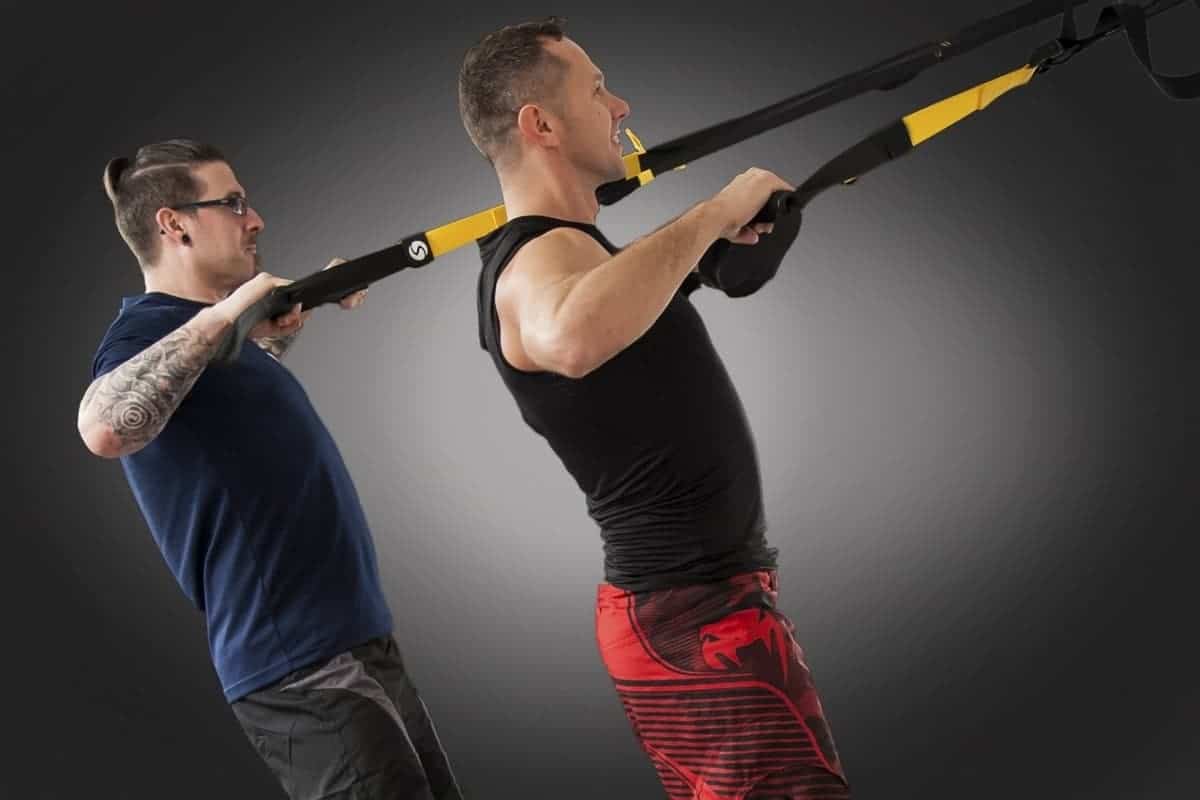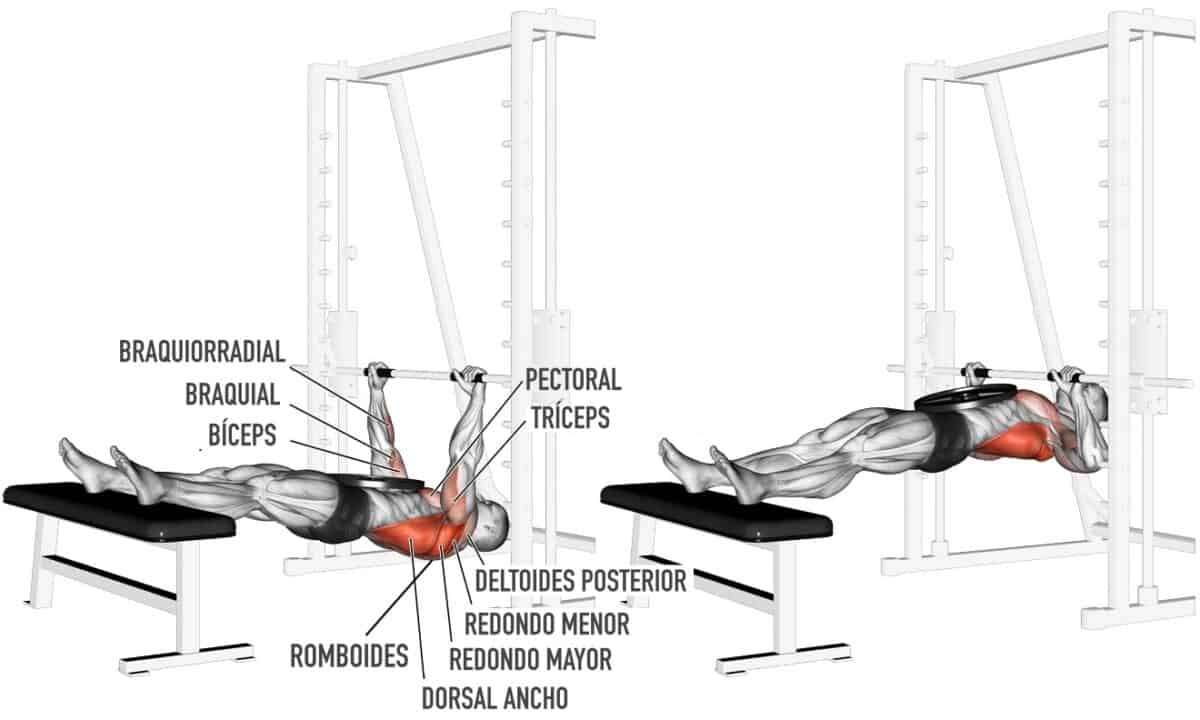The following article aims to analyze in depth the exercise of the inverted row: how it is performed correctly, which muscles are activated, what variants exist, how to progress, etc.
The inverted row is an exercise that uses body weight as resistance and activates many muscle groups during the movement.
Additionally, it is an exercise that can be easily adapted to the person’s level and is included in programs for improving strength and hypertrophy as well as injury rehabilitation.
What is the inverted row?
The inverted row is a closed kinetic chain exercise, multi-joint and horizontal pull according to the movement patterns of the human body (1).
This exercise uses body weight as resistance, so it is classified as a bodyweight exercise in which around 68-79% of body weight is lifted (4).
The goal of the exercise is to perform a pulling movement with the arms to bring the body closer to the bar or grip, thus activating the dorsal muscles, deltoids, rhomboids, trapezius, etc.
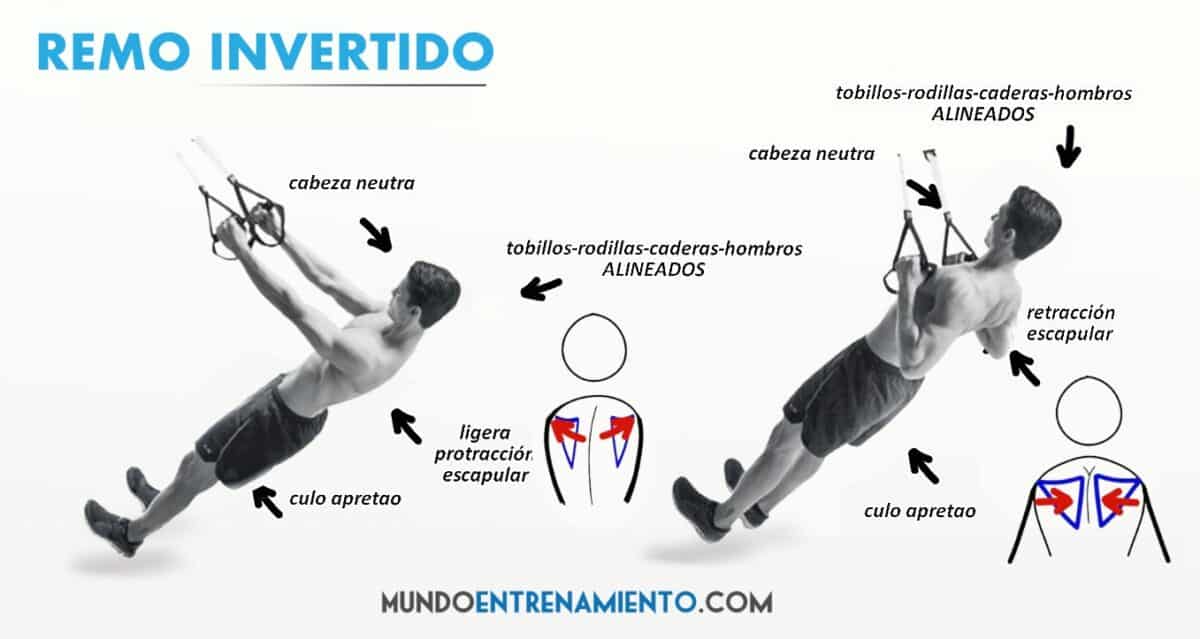
How is the inverted row done?
The complete movement of the inverted row can be divided into the following phases (1):
Initial position
- The person positions themselves under a bar in a rack or in the multipower machine, placing the chest at the height of the bar.
- The hands are placed in pronation with a separation greater than shoulder width.
- The arms are extended, and the body is completely aligned from the feet to the head.
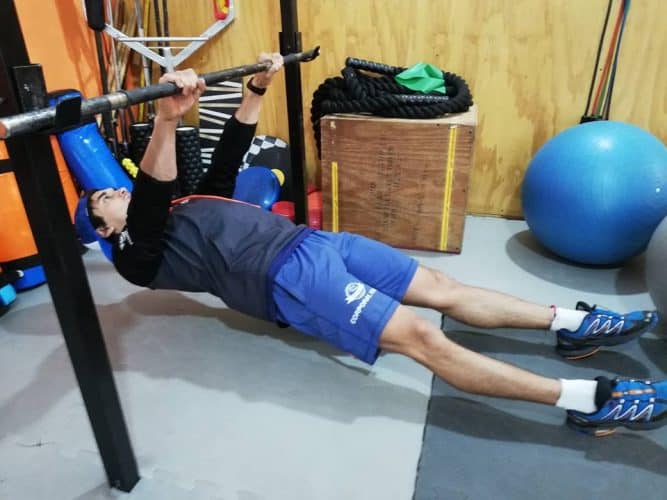
Elevation (concentric phase)
- The person flexes the arms to bring the body closer to the bar while keeping the body straight during the movement.
- The elbows and wrists flex due to the concentric action of the biceps and wrist flexors.
- The shoulder performs horizontal abduction due to the concentric action of the latissimus dorsi, teres major, posterior deltoid, and infraspinatus muscle.
- The instructions that can be given to the person performing it can be: ‘keep the head, neck, and body in line with the legs’, ‘keep the chest high’, ‘bring the shoulder blades back and down’, and ‘pull the arms and elbows down’.
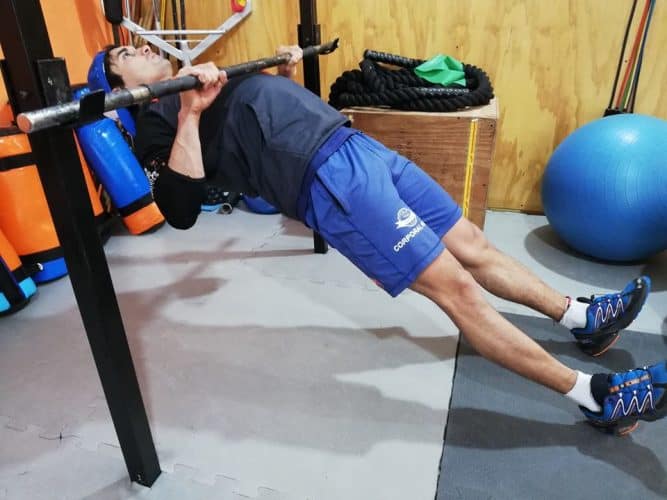
Descent (eccentric phase)
- The person extends the arms while keeping the shoulders down during the movement.
- The body remains straight.
- The instructions that can be given to a person executing the movement are ‘descend slowly’, ‘avoid falling’, and ‘lower straight’.
What muscles are worked in the inverted row?
As we mentioned earlier, the inverted row is a multi-joint exercise in which many muscle groups participate in different ways.
Next, we will analyze the inverted row and which muscles work. The muscles that are mainly activated concentrically and/or eccentrically during the inverted row are (1):
- Middle trapezius
- Lower trapezius
- Rhomboids
- Posterior deltoid
- Infraspinatus
- Latissimus dorsi
- Biceps brachii
- Forearm muscles
Additionally, other muscle groups are activated isometrically to stabilize the body during the movement:
- External oblique
- Spinal erectors
- Gluteus maximus and medius
- Biceps femoris
CMJ Fenwick et al. (2009) studied the muscle activation of the torso and hip in 3 different types of rowing: the inverted row, the barbell row, and the one-arm cable row (2).
The results showed that the inverted row is the most suitable exercise for working the involved musculature with the least load on the lumbar area. Additionally, the latissimus dorsi was activated in the same way in the barbell row as in the inverted row.
Regarding the spinal erectors of the thoracic area, they were activated to a greater extent with the inverted row than in the other exercises.
Variants of the inverted row
Like many exercises, this row has many variants related to the type of grip, the number of supports on the ground, the material used, etc.
The standard inverted row is performed with the legs extended, both feet on the ground, with a pronated grip and on a fixed bar.
The following variants of the inverted row are distinguished:
- With suspension training straps
- In supination
- With 3 supports
Inverted row with suspension training straps
This type of inverted row is performed with suspension training straps. This represents a substantial change compared to the standard row since the grip with the straps is unstable.
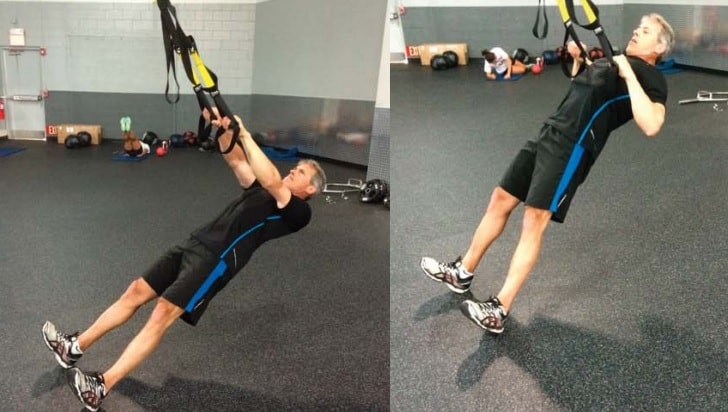
S Harris et al. (2017) compared muscle activation in a standard inverted row and using suspension training straps, among others (5).
There was a significant increase in the row with straps in the middle portion of the deltoid, rectus abdominis, and obliques.
R Snarr et al. (2014) studied the muscle implications of the latissimus dorsi, posterior deltoid, biceps brachii, and middle trapezius with different grips and with suspension training straps (6).
The results showed an increase in muscle activation using the suspension training straps compared to the standard row in: latissimus dorsi, biceps brachii (supinated grip), and posterior deltoid.
Inverted row with neutral grip using the suspension trainer
In turn, this type of row can be further modified, as this material allows performing the pulling movement with a neutral grip.
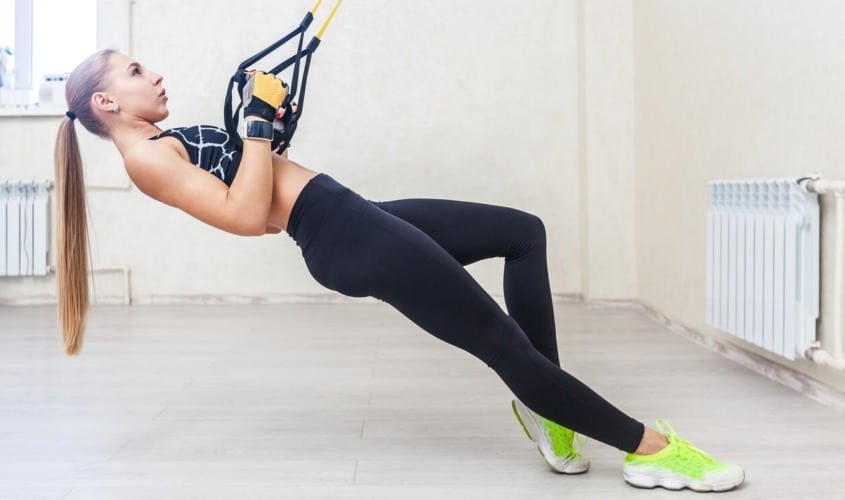
Currently, there is no study that has investigated the inverted row with a neutral grip using the suspension trainer.
This type of grip presupposes, from a biomechanical point of view, a greater activation of the latissimus dorsi due to the elbows being closer to the body, while the activation of the middle and lower trapezius will be less for the same reason.
Inverted row in supination
This variant of the standard inverted row is performed with a supinated grip of the hands.

JW Youdas et al. (2016) studied the differences between the inverted row in pronation and supination in different muscles of the upper body and abdomen (3).
The authors concluded that the row performed with a supinated grip significantly increases the activation of the latissimus dorsi. The biceps brachii also increased its activation in this grip but not significantly.
R Snarr et al. (2014) also investigated the differences between the standard inverted row (in pronation) and in supination through electromyography (6).
On this occasion, the authors found that the activation of the latissimus dorsi was less with a supinated grip than with the pronated grip.
Therefore, more research is needed to provide clarity on the differences between the standard inverted row and in supination.
Inverted row with 3 supports
In the current scientific literature, there are some studies that have investigated muscle activation in different inverted rows with 3 supports and different grips.
JW Youdas et al. (2016) investigated the muscle involvement of the inverted row with 3 supports in supination and pronation (3).
The only significant difference they found was a greater activation of the upper trapezius in the inverted row with 3 supports with the pronated grip.
JW Youdas et al. (2020) re-analyzed the following types of row and their muscle involvement (7):
- With 3 supports and in supination.
- With 3 supports, in supination, and with a load.
- With 3 supports, in supination, and with support on an unstable surface.
- With 3 supports, in supination, with foot support on an unstable surface, and with a load.
The authors found no significant differences in the muscle activation of 11 muscles analyzed between the different variants with 3 supports.
Progression in the inverted row
The inverted row is an exercise that can be easily modified to make it more or less intense. This versatility allows it to be adapted to people of different fitness levels or with different goals easily.
This exercise is widely used to improve pulling strength in training programs for pull-ups, one of the exercises frequently measured in many physical tests.
The main variable that will determine the difficulty of the exercise will be the inclination of the person.
Beginners
Beginner individuals can include this exercise in their training routines by performing the exercise in a more vertical position, thus facilitating both the technical requirements and the strength demands of the exercise.
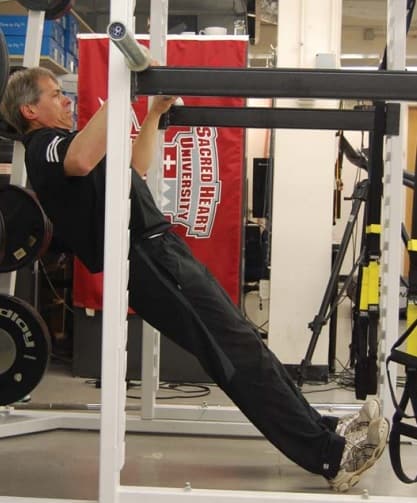
Intermediate level
Individuals with some physical fitness would perform this row in a standard way, that is, in a lying position parallel to the ground and with the legs fully extended.
However, this type of row is easier if the person has the legs bent since the length of the body being lifted is shorter (4).
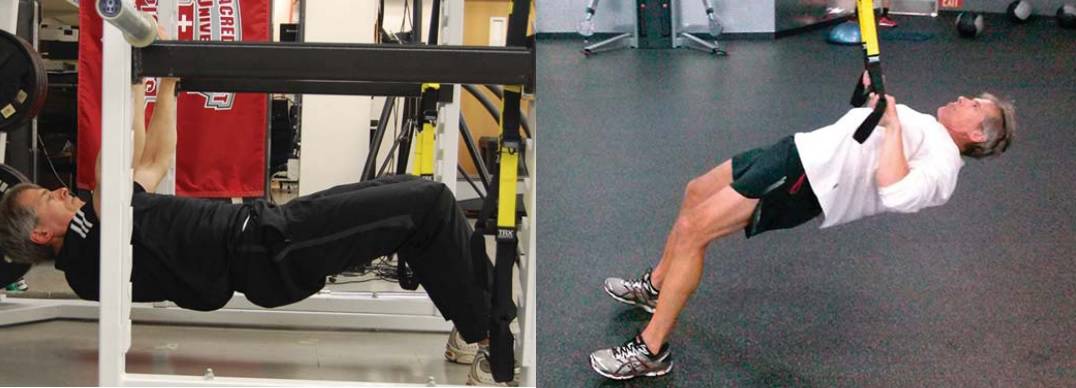
Advanced level
For those with a high level of physical fitness, the exercise could be performed by elevating the feet on a box or bench. This elevation requires greater strength demands as more body weight is supported by the arms than the legs (1,4).

Another way to increase the difficulty would be to perform the standard inverted row with a weighted vest (1,4).
Conclusions
The inverted row is an exercise that presents a great activation of the back musculature (trapezius, latissimus dorsi, rhomboids, etc.), arm flexors, etc. with a low load on the lumbar area.
Performing the inverted row with suspension training straps improves the activation of the latissimus dorsi, biceps brachii, and posterior deltoid.
In this exercise, 68-79% of body weight is lifted, making it an exercise included in both hypertrophy programs, performance improvement in physical tests, injury rehabilitation, etc.
More research is needed to verify the differences in muscle activation of the exercise performed with a pronated or supinated grip.
The exercise can be adapted so that it can be performed by both beginners and high-performance athletes.
Bibliographic references
- Ronai, P., & Scibek, E. (2014). The inverted row. Strength & Conditioning Journal, 36(4), 94-97. Link.
- Fenwick, C. M., Brown, S. H., & McGill, S. M. (2009). Comparison of different rowing exercises: trunk muscle activation and lumbar spine motion, load, and stiffness. The Journal of Strength & Conditioning Research, 23(5), 1408-1417.
- Youdas, J. W., Keith, J. M., Nonn, D. E., Squires, A. C., & Hollman, J. H. (2016). Activation of spinal stabilizers and shoulder complex muscles during an inverted row using a portable pull-up device and body weight resistance. Journal of strength and conditioning research, 30(7), 1933-1941.
- Ronai, P., Scibek, E., & Dawes, J. (2016). The Suspension Inverted Row. Strength and Conditioning Journal, 38(4), 106-112.
- Harris, S., Ruffin, E., Brewer, W., & Ortiz, A. (2017). Muscle activation patterns during suspension training exercises. International journal of sports physical therapy, 12(1), 42.
- Snarr, R., Nickerson, B., & Esco, M. (2014). Effects of hand-grip during the inverted row with and without a suspension device: An electromyographical investigation. Euro J Sports Exerc Sci, 3, 1-5.
- Youdas, J. W., Hubble, J. W., Johnson, P. G., McCarthy, M. M., Saenz, M. M., & Hollman, J. H. (2020). Scapular muscle balance and spinal stabilizer recruitment during an inverted row. Physiotherapy theory and practice, 36(3), 432-443.
